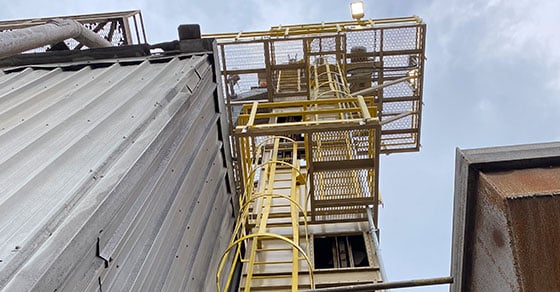Bucket elevators are the standard for vertical conveying in nearly every industry handling bulk solids. No matter what the industry, ensuring the elevator is both safe and accessible is critical to complying with regulatory requirements, promoting efficient operation and equipment longevity, and not least of all, safeguarding plant personnel.
The following covers the various options and design modifications available for maximizing the accessibility and safety of bucket elevators.
Accessibility
While significant consideration is given to the overall design of a bucket elevator, one often-forgotten aspect is the accessibility of the unit.
The ability to safely and easily access the bucket elevator is essential for maintaining efficient operation and promoting maximum service life, allowing for critical routine monitoring and repairs. The following upgrades and modifications should be considered based on the specific production demands and facility infrastructure.
Service Platforms, Ladders, Walkways, Cages
Service platforms, ladders, walkways, and safety cages provide plant personnel with safe options for accessing the elevator when monitoring or maintenance are needed.
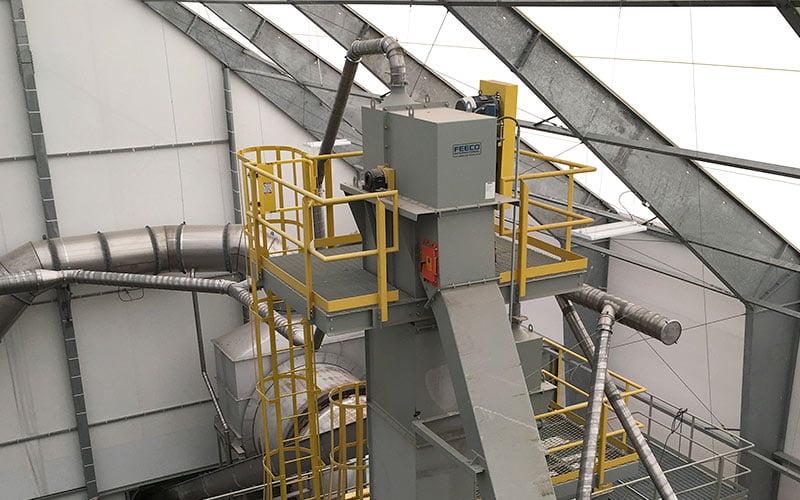
Bucket elevator with service platform and ladders with safety cages. A dust pick-off point, as well as an inspection door at the discharge (orange) can also be seen.
Access & Inspection Doors
Access doors provide an access point to the elevator’s internals without having to remove or cut away parts of the casing. This allows for simplified access and maintenance.
While access doors provide a point of access large enough to facilitate necessary repairs, inspection doors offer a small window for observation. Ideally, both sides of the discharge should have an inspection door so operators can observe the unit in operation and make troubleshooting any issues that arise faster and easier.
FEECO incorporates access and inspection doors as standard features on all elevators, typically consisting of two inspection doors at the head, as well as a removable hood for full access to the head pulley/sprocket and shaft, four access doors at the boot, and one set of access doors at the intermediate casing (usually the first casing above the boot). A set of access doors at each floor level to further increase accessibility can be incorporated upon request.
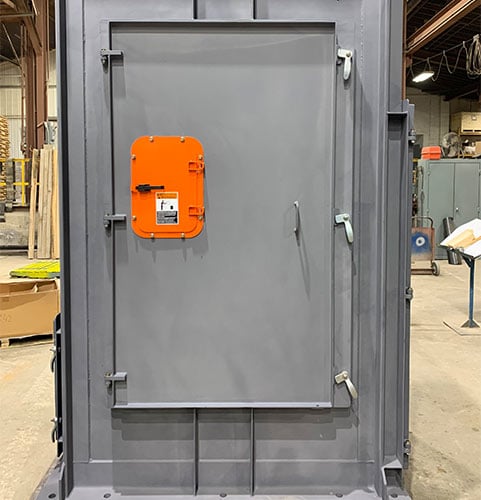
Bucket elevator boot casing with access door and inspection door
Gravity take-up (Chain Elevators Only)
A gravity take-up, or GTU, is standard on most chain elevators. However, it’s worth mentioning them as an upgrade for low-capacity, single-chain elevators where the screw take-up is also an option.
While these smaller elevators can safely employ the screw-type take-up, upgrading to a GTU offers a number of advantages, particularly when it comes to safety.
Unlike a screw take-up, which requires manual adjustment, a GTU is self-adjusting, eliminating the need for human-equipment interaction in managing chain tension. A GTU also eliminates the potential for fugitive material escaping the boot, as it is internally contained (the boot shaft does not penetrate the casing).
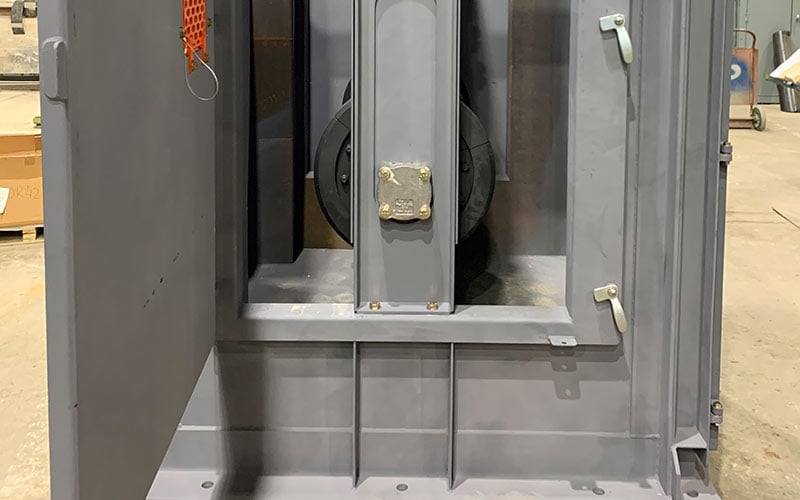
Gravity take-up in boot (with access door)
Instrumentation & Sensors
Bucket elevators can be equipped with a number of sensors and instrumentation for condition monitoring. Sensors can be integrated into a programmable logic control (PLC), motor control center (MCC), and human machine interface (HMI) for various levels of data tracking and trending, as well as alerting operators to potential issues. The ability to catch problems at their onset is particularly valuable, as it provides an opportunity for early intervention to minimize production issues and damage to equipment.
Sensors
GTU Over Travel Switch
A GTU over travel switch alerts operators of excessive chain stretch. A chain that stretches past the level of warning may indicate it’s time for maintenance or replacement.
Boot Level Fill Switch
A boot level fill switch alerts operators that material is filling the elevator boot.
Motion Sensor or Zero-Speed Switches
Depending on the type of take-up in use, motion sensors or zero-speed switches can be used to let operators know that the shaft (zero-speed switch) or buckets (motion sensor) have stopped moving.
Temperature Sensors
Typically employed at the head bearings, temperature sensors detect excessive heat, which may indicate that the bearings need to be regreased or even replaced.
Temperature sensors are also common in monitoring gear reducer oil temperature, which, if elevated, could indicate a problem.
Vibration Sensors
Similarly, vibration sensors are often used at the head bearings and gear reducers. Excessive vibration in these areas may indicate an issue.
Plugged Chute Switches
Plugged chute switches indicate that a chute is plugged. This could be a result of material bridging or sticking, a damaged spot in the chute, insufficient chute design, or even an upset condition causing more moisture or flow rate than usual.
When a chute plugs, the entire system typically backs up with material, which often leads to a failure somewhere in the system, making plugged chute switches vital in preventing larger issues.
Oil Quality and Oil Level Sensors
Oil quality and level sensors are used on gear reducers to monitor oil conditions and alert the operator when maintenance is potentially required.
E-stops
Emergency stop buttons should be incorporated at feed and boot areas where inspection and repairs are common. E-stops are vital in minimizing injury to personnel and damage to equipment in the event of an issue.
Explosion Protection
When working with a combustible dust, such as coal, or in settings where chemical reactions could occur, measures to protect against explosion are critical.
In the event of an explosion, venting panels are designed to blow under a rated pressure, keeping explosive forces contained to specific areas. Without these panels, any explosion would be uncontrolled.
Explosion suppression canisters, similar to fire extinguishers, are also available. These can be incorporated to detect and suppress combustion inside the unit, stopping an explosion before it has a chance to grow.
Care should also be taken in selecting the materials of construction for both casing and buckets when working with combustible materials or a high potential for fire.
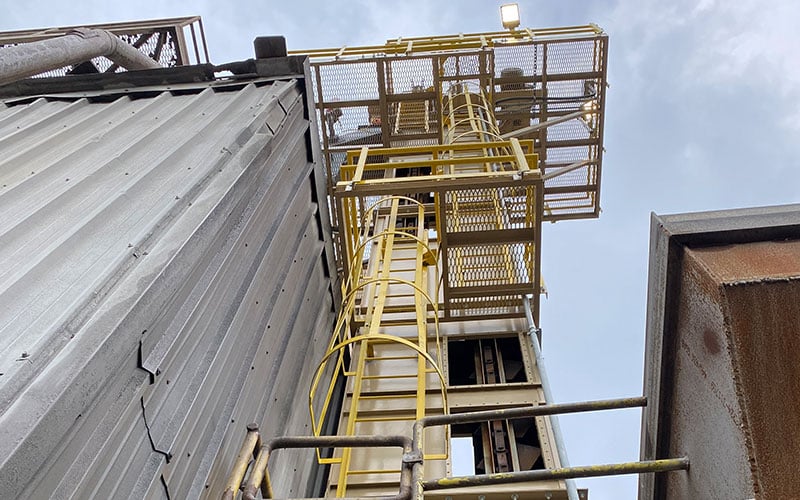
Bucket elevator with ladders (with safety cages), service platforms, and explosion venting panels (not yet installed)
Dust Mitigation
Dust mitigation is an essential aspect in several settings, particularly when dust presents a combustion risk, air quality hazard, or even a housekeeping problem that could encourage slips and trips.
Dust pick-off points can be incorporated into the elevator at the head section (as shown in an earlier image). These points create a vacuum which captures dust and re-routes it to a filtration system or baghouse, preventing the escape of dust into the air.
Fully seal-welded casings can also be utilized to protect against dust, eliminating potential avenues of escape, keeping material contained within the elevator, and preventing corrosion.
General Safety Tips for Bucket Elevators
In addition to designing bucket elevators according to their anticipated duty, a number of practices can help to further maximize safety.
Prioritize Housekeeping
Keep the area surrounding equipment clean and free of debris and fugitive material. The accumulation of such material can interfere with equipment operation in unexpected ways, as well as create potential fall risks or other safety hazards.
Be Proactive
The best way to avoid problems is to prevent them from the start. Beyond employing sensors and instrumentation to alert to potential issues, plant personnel should take a proactive approach to maintenance. This includes conducting routine inspections, carrying out repairs, and replacing worn or damaged components prior to failure. Never allow an elevator to operate with damaged components. Keeping an inventory of bucket elevator parts is also helpful in this effort.
Follow all OEM recommendations for operation, lubrication, and maintenance.
Train Employees
Employees should be thoroughly trained in the proper operation and maintenance of the elevators they work around. This should include training on standard safety procedures such as Lockout/Tagout (LOTO), as well as site-specific hazards.
Conclusion
While bucket elevators are the industry standard for vertically conveying bulk materials, they require a number of considerations to ensure that equipment is safe, accessible, and built for longevity.
FEECO has been the industry leader in manufacturing custom bucket elevators since 1951. For more information on our bucket elevators, or parts and service support, contact us today!



